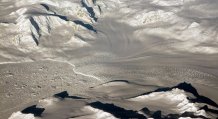
The West Antarctic Ice Sheet. Image courtesy of NASA/Michael Studinger.
Research reveals West Antarctic Ice Sheet loss over the last 11,000 years
Wind-driven incursions of warm water have forced the retreat of glaciers in West Antarctica over the last millennia, new research has revealed.
A team of international researchers, including Dr Sev Kender from the University of Exeter, have studied the true extent by which the West Antarctic Ice Sheet (WAIS) has retreated over thousands of years.
The WAIS has major significance for scientists, as two of its largest glaciers, Thwaites and Pine Island, are draining into the sea and contributing to sea-level rise. However, questions have remained as to why this is happening, by how much, and what may happen in the future under climate change.
In the new study, published in the leading scientific journal Nature, the research team studied tiny shells in seafloor sediment cores retrieved from Pine Island Bay in West Antarctica.
From this research, they have been able to reconstruct the interactions between the ice and ocean from 11,000 years ago right up until the present day. They describe the West Antarctic Ice Sheet (WAIS) as having experienced significant and sustained ice loss until 7,500 years ago, driven by warm water incursions. The influx of warm water then subsided for several thousands of years until it was reinvigorated in the 1940s, driving further retreat.
These new results enable researchers to better understand how environmental change may impact future sea-level rise from this climate-sensitive region.
Dr Kender, a co-author on the study from the Camborne School of Mines, based at the University of Exeter’s Penryn Campus in Cornwall said: “This study is particularly interesting, as it shows that the only time in the past that warm water was present under the Pine Island ice shelf was before 7,500 years ago. This indicates that the recent warm water incursions since the 1940s are unprecedented. We were able to identify the species and measure the chemistry of microfossil shells (named foraminifera), which are powerful tools for reconstructing past oceans. These warm water incursions that melt ice shelves appear to be controlled by wind strength which is linked to global temperature.”
Lead author Dr Claus-Dieter Hillenbrand senior marine geologist at BAS said: “This ten-year study has yielded some exciting results. By understanding the mechanisms that caused the retreat of the WAIS over the past several thousand years, we can begin to build a clearer picture of what is happening today.”
Data collected over the last 20 years have shown that the present ice loss in West Antarctica results from the relatively warm water from the deep ocean flowing on to the shallow continental shelf. This warm water reaches the coastline in places, where it triggers substantial melting of the floating parts of glaciers and leads to thinning of the ice upstream.
Dr Hillenbrand added: “Ice loss from this part of West Antarctica is already making a significant contribution to sea-level rise – around 1 mm per decade, and is actually one of the largest uncertainties in global sea-level rise predictions. Whilst this is a small figure in actual terms, combined with the contribution from other melting glaciers around the world and expansion of the world’s oceans, it will have an impact upon society through flooding of low-lying coastal regions”.
“Understanding what happened in the distant past provides another important part of the jigsaw. Computer model simulations have suggested that ice-sheet melting through warm water incursions could initiate a collapse of the WAIS within the next few centuries, raising global sea-level by up to 3.5 metres.”
The team investigated sediment cores collected from Pine Island Bay in the Amundsen Sea from the German research vessel RV Polarstern on two expeditions in 2006 and 2010. The team analysed the chemical composition of tiny shells built by organisms (foraminifera) that had lived in the water column and at the sea bottom before their shells became embedded in the seafloor sediments. This chemical composition acts as a ‘fingerprint’ of the water that the shells were formed in. By comparing these shells with those of modern shells bathed in warm deep water today the researchers were able to identify time intervals when warm deep water was either present or absent.
Pine Island Glacier is one of the most inhospitable areas in Antarctica to investigate and researchers have only been exploring this area since the 1990s.
The study was a collaboration between British Antarctic Survey (NERC), the Alfred Wegener Institute, Universities of Cambridge, Leicester and Exeter, the British Geological Survey, University College London and the Universities of Copenhagen and Tromsø.
Date: 6 July 2017
